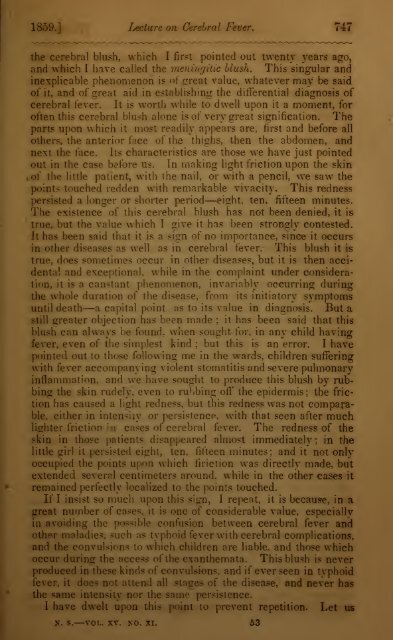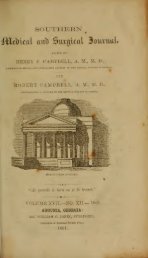—746 Lecture on Cerebral Fever. [November,child, surprised <strong>and</strong> troubled the mother. Its sleep became broken<strong>and</strong> unequal, but there was an absence of one symptom sofrequently seen at the commencement of this disease; it had noneof those startings from sleep, accompanied by a peculiar cry,which I shall have to describe in giving an account of this terribleaffection. Eight days ago vomiting commenced. Everythingwhich was given to it, drinks of various kinds, <strong>and</strong> its naturalfood, were thrown up again, <strong>and</strong> the mother became seriouslyalarmed. Her apprehensions were increased five days ago, bythe appearance of another symptom, which she has well describedto us, <strong>and</strong> which it is essential to mark. Whenever she took upthe child it commenced to cry ; it seemed as if every touch gaveit acute pain ; <strong>and</strong> this was the fact, for there was then generalhyperesthesia. Finally, four days ago, convulsions came onfirst on the right side, then on the left ; <strong>and</strong> then the little patientwas brought here. Let us pass rapidly in review the symptomswhich it presented, <strong>and</strong> compare them with those which mayoccur in other similar affections.At first sight we observed strabismus—convergent strabismusof the right eye, the pupil of which was dilated, but not so widelyas that of the left. Upon that side the child seemed blind, forupon moving the finger rapidly before the left eye, there was noclosure of the lids, that natural <strong>and</strong> involuntary movement for theprotection of the menaced organ. There was then blindness, orgreat feebleness of vision ; <strong>and</strong> this is an accident of cerebralfever, which children who can talk complain of readily, <strong>and</strong>which is here very plainly indicated by the wide dilatation ofthe pupil, <strong>and</strong> the convergent strabismus of the other eye. Weobserved, besides, a slight bending of the head backwards, <strong>and</strong> somestiffness of the left arm, which was agitated from time to timewith movements of extension <strong>and</strong> flexion. The thumb of thisside was forcibly adducted into the palm of the h<strong>and</strong> <strong>and</strong> coveredby the fingers convulsively flexed upon it ; this flexion, however,yielded readily to our attempts at extension. Upon removingthe child's clothing, we observed that the abdomen was excavated,hollowed out—a symptom almost, constantly to be met within cerebral fever, <strong>and</strong> of great value, as it serves, in a large numberof cases, to distinguish the disease from cerebral affectionsoccurring secondarily in other diseases—typhoid fever, for example.When the h<strong>and</strong> was carried to the face of the child, as Idid to examine its mouth in regard to dentition, we were struckwith the redness which immediately colored the skin. And if wepassed the nail over the abdomen, however lightly, in such a manneras to make longitudinal <strong>and</strong> transverse lines, thirty secondsdid not elapse before the whole surface was covered with a livelyredness, which, diffuse at first, remained along the lines wherethe nails passed, of a more intense <strong>and</strong> persistent color. This is
• of1859.] Lecture on Cerebral Fever. 747the cerebral blush, which I first pointed out twenty years ago,<strong>and</strong> which I have called the meningxtic blush. This singular <strong>and</strong>inexplicable phenomenon is of great value, whatever may be saidof it, <strong>and</strong> of great aid in establishing the differential diagnosis ofcerebral fever. It is worth while to dwell upon it a moment, foroften this cerebral blush alone is of very great signification. Theparts upon which it most readily appears are, first <strong>and</strong> before allothers, the anterior face of the thighs, then the abdomen, <strong>and</strong>next the face. Its characteristics are those we have just pointedout in the case before us. In making light friction upon the skinthe little patient, with the nail, or with a pencil, we saw thepoints touched redden with remarkable vivacity. This rednesspersisted a longer or shorter period—eight, ten, fifteen minutes.The existence of this cerebral blush has not been denied, it istrue, but the value which I give it has been strongly contested.It has been said that it is a sign of no importance, since it occursin other diseases as well as in cerebral fever. This blush it istrue, does sometimes occur in other diseases, but it is then accidental<strong>and</strong> exceptional, while in the complaint under consideration,it is a canstant phenomenon, invariably occurring duringthe whole duration of the disease, from its initiatory symptomsuntil death—a capital point as to its value in diagnosis. But astill greater objection has been made;.it has been said that thisblush can always be found, when sought for. in any child havingfever, even of the simplest kind ; but this is an error. I havepointed out to those following me in the wards, children sufferingwith fever accompanying violent stomatitis <strong>and</strong> severe pulmonaryinflammation, <strong>and</strong> we have sought to produce this blush by rubbingthe skin rudely, even to rubbing off the epidermis; the frictionhas caused a lisrht redness, but this redness was not comparable,either in intensify or persistence, with that seen after muchlighter friction in cases of cerebral fever. The redness of theskin in those patients disappeared almost immediately; in thelittle girl it persisted eight, ten, fifteen minutes; <strong>and</strong> it not onlyoccupied the points upon which firiction was directly made, butextended several centimeters around, while in the other cases itremained perfectly localized to the points touched.If I insist so much upon this sign, I repeat, it is because, in agreat number of cases, it is one of considerable value, especiallyin avoiding the possible confusion between cerebral fever <strong>and</strong>other maladies. such as typhoid fever with cerebral complications,<strong>and</strong> the convulsions to which children are liable, <strong>and</strong> those whichoccur during the access of the exanthemata. This blush is neverproduced in these kinds of convulsions, <strong>and</strong> if ever seen in tvphoidfever, it does not attend all si >he disease, <strong>and</strong> never hasthe same intensity nor the same persistence.I have dwelt upon this point to prevent repetition. Let usN. 5. VOL. XV. SO. XI. 53
- Page 1 and 2: SOUTHERNMEDICAL AND SUBGICAL JOURNA
- Page 3 and 4: 1859.] Climate to the Consumptive,
- Page 5 and 6: 1859.] Climate to the Consumptive,
- Page 7 and 8: Aug.Oct.1859.] Climate to the Consu
- Page 9 and 10: 1859.] Climate to the Consumptive,
- Page 11 and 12: 1859.] Climate to the Consumptive,
- Page 13 and 14: 1S59.] Climate to tJte Consumptive,
- Page 15 and 16: 1859.] Climate to l/ie Consumptive,
- Page 17 and 18: 1859.] Climate to the Consumptive,
- Page 19 and 20: 1859.] Climate to the Consumptive,
- Page 21 and 22: 1859.] Dugas, on Fracture of Hie Sc
- Page 23: 1869.] Lecture upon Cerebral Fever.
- Page 27 and 28: 1859.] Lecture on Cerebral Fever. 7
- Page 29 and 30: 1859.] Lecture on Cerebral Fever. 7
- Page 31 and 32: 1859.] Lecture on Gerebral J' 753un
- Page 33 and 34: 1859.] Lecture on Cerebral Ftthey a
- Page 35 and 36: :1859.] Attempted Abortion and Deat
- Page 37 and 38: 1859.] Attempted Abortion and Death
- Page 39 and 40: :—:1859.] Diphtheria. 761by its o
- Page 41 and 42: —:1859.] Diphtheria. 763ride of i
- Page 43 and 44: ——1859.] Diarrhoea of Infants a
- Page 45 and 46: 1859.] Action of Mercury on the Sec
- Page 47 and 48: 1859.] Defective Assimilation in In
- Page 49 and 50: —1859.] Cancerous Ulceration clos
- Page 51 and 52: —1859.] Vegetation of the Genital
- Page 53 and 54: 1859.] Gases of Suppression of the
- Page 55 and 56: 1859.] Cases of Suppression of the
- Page 57 and 58: ——;1859.] After-treatment of th
- Page 59 and 60: 1859.] Dr. 0. C. Gibbs. Summary. 78
- Page 61 and 62: 1859.] Dr. 0. C. GrBBS. Summary, 78
- Page 63 and 64: :;1859.] Secale Cornulam for t?ie E
- Page 65 and 66: 1859.] Divisions for the Cure of De
- Page 67 and 68: ;1859.] Incision in Anthrax. 789Inc
- Page 69 and 70: :;1859.] Editorial and Miscellaneou
- Page 71 and 72: ———and1859.] Miscellaneous. 7








